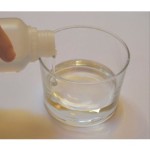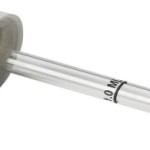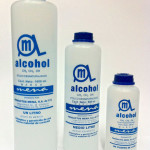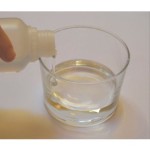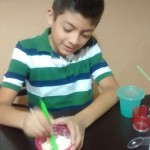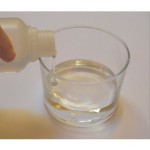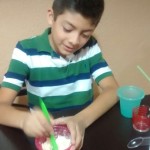Gel Antibacterial Casero
Gel Antibacterial Casero
Categoría: Pandilla Kids (3ro., 4to., 5to. y 6to. Año de primaria)
Área de participación: Ciencias de los Materiales
Resumen
Este proyecto fue creado para dar a conocer a los estudiantes de esta escuela, como se elabora el gel antibacterial con el fin de promover medidas preventivas, normas y hábitos de higiene en la escuela Zama, siendo una forma sencilla y barata de lograr estos beneficios.
Por todo esto surgió mi interés de presentarles un gel antibacterial, para preservar el estado de salud de los estudiantes, ya que las manos son el principal vehículo de transmisión de la infección por contacto directo o indirecto a través de superficies.
La fricción higiénica de las manos con este gel antibacterial, es un poco más efectivo que el lavado de las mismas, aunque no reemplaza este procedimiento en presencia de mugre.
Además, es un producto que limpia nuestras manos sin necesidad de usar agua y las desinfecta sin necesidad de usar toallas o jabón. Su principal atributo es que no es agresivo a la piel y no la reseca, y se distingue al ofrecer suavidad, humectación y frescura.
Pregunta de Investigación
¿como se elabora el gel antibacterial?Planteamiento del Problema
Los gérmenes existen en todas partes: puede haber más de 3.000 en cada centímetro cúbico de nuestros escritorios, sobre los teclados de las computadoras y en los picaportes. Ciertos virus pueden sobrevivir hasta más de veinte minutos en la superficie de los objetos La falta de agua en muchas escuelas es un problema muy grave y por lo cual también la higiene en los baños de hombres y mujeres puede verse afectado, esto puede deberse a varias situaciones: Por una parte, está el poco interés que muestran los alumnos en mantener la limpieza del inmobiliario pensado específicamente para su beneficio, pero también, puede ser que los intendentes o los directivos no estén poniendo la atención suficiente al cuidado y mantenimiento de los baños.
A medida que entramos en contacto con muchas cosas diferentes todos los días, transportamos gérmenes en nuestras manos. Por eso, según los expertos, el lavado con agua y jabón puede prevenirnos de:
* Enfermedades diarreicas.
* Enfermedades respiratorias.
* Parásitos intestinales.
* Infecciones en la piel y en los ojos
Antecedentes
Es un producto antiséptico que se emplea como alternativa al agua y el jabón para lavarse las manos. El Gel Antibacterial es un producto que limpia tus manos sin necesidad de usar agua y, desinfecta las manos sin necesidad de usar toallas o jabón. Elimina 99.9% de los gérmenes al contacto y es superior a todos los productos en el mercado porque contiene micro-esferas de vitamina E que humectan tu piel, con un aroma suave.
El alcohol en gel, también conocido como gel antiséptico, gel desinfectante, gel de alcohol, gel limpiador bactericida, es un producto antiséptico que se emplea como alternativa al agua y el jabón para lavarse las manos. Los principios activos en la mayoría de los geles sanitizantes son alcohol isopropílico, etílico o propílico. Sin embargo, también existen
geles desinfectantes sin alcohol, con cloruro de benzalconio y triclosán
LA PIEL
La piel es el órgano sensitivo más grande del cuerpo humano, constituye aproximadamente el 15% del peso total corporal, recoge información a través de una extensa red de neuronas y terminales nerviosas. Aportan información sobre presión, vibración, dolor y temperatura.
Estructura de la piel y sus funciones
La piel cumple diversas funciones:
- Protección.
- Regulación térmica.
- Percepción sensitiva.
- Respuestas inmunitarias.
- Evita la perdida de fluidos hacia el exterior – Participa en la síntesis de vitamina D.
Es un órgano en permanente estado de actividad, consta de tres capas, la epidermis, dermis, hipodermis. La epidermis es la capa superficial,
consta de queratinocitos, melanocitos, células de Langerhans y células de Merkel. Tiene varios estratos: basal, espinoso, granuloso y corneo. La dermis consta de dermis papilar y dermis reticular, se compone de tejido conectivo se encuentran fibroblastos, mastocitos, macrófagos, dendrocitos.
Infecciones bacterianas en la piel
Las infecciones causadas por bacterias pueden afectar una zona específica o propagarse por una zona extensa de la piel, así como producir la infecciona nivel de la dermis, epidermis y tejido subcutáneo.
Dependiendo de tres factores:
Propiedades patógenas de los agentes bacterianos
Integridad de la puerta de entrada.
Capacidad de defensa del organismo
Objetivo
Elaborar un gel Antibacterial para lavar y desinfectar correctamente las manos y proporcionar a los alumnos cuidado y conservación de un ambiente saludable.
Tomar conciencia y tener presente las normas de higiene para prevenir cualquier enfermedad.
Conocer la importancia del uso del Gel Antibacterial como medida preventiva y de higiene.
Justificación
El gel Antibacterial es un excelente compuesto desinfectante para las manos. Su formulación especialmente balanceada permite un alto grado de desinfección eliminando en cuestión de segundos bacterias, hongos, esporas y otros microorganismos peligrosos a la salud humana, además de que contiene agentes humectantes para evitar resequedad de la piel.
El proyecto tiene una gran importancia puesto que a partir de este se dará a conocer un producto que brindara soluciones a problemas ambientales que afectan la salud humana y el cual será de fácil adquisición para los alumnos ya que su costo no es muy elevado, pues este pretende brindar economía.
La fricción higiénica de las manos con un gel Antibacterial, es un proceso más efectivo que el lavado de las mismas, aunque no reemplaza este procedimiento en presencia de mugre visible y secreciones.
El gel Antibacterial, es un producto que limpia las manos sin necesidad de usar agua y, las desinfecta sin necesidad de usar toallas o jabón. Su principal atributo a diferencia de otros es que no es agresivo a la piel y no la reseca, por lo que se distingue por la suavidad que
dejará en la piel al humectarla y protegerla.
Hipótesis
El gel Antibacterial es un excelente compuesto desinfectante para las manos.
Si conocemos lo sencillo de su elaboración y los beneficios en nuestra salud, indudablemente lo utilizaremos adecuadamente y nos mantendremos sanos.
Método (materiales y procedimiento)
- METODOLOGÍA
“LA HIGIENE DE LAS MANOS”
La propuesta comprende los siguientes procedimientos:
- Comprar los reactivos, los recipientes plásticos o dispensadores y los soportes para instalar los recipientes en los salones, baños, comedor, dirección, biblioteca, sala de profesores y otras áreas de la institución.
- Elaboración del gel Antibacterial en casa con la supervisión de un adulto.
- Entrega del gel o producto para su respectivo uso.
- Llenar los dispensadores de gel Antibacterial cada vez, que los líderes del proyecto estimen conveniente.
Materiales y equipos para elaborar el gel Antibacterial:
- Agitador
- Mortero
- Goteros
- Pipetas
- Embudo
- Vaso de precipitación
- Recipiente con Capacidad para 2 L.
- Guantes
- Balanza
- Frascos de plástico
- Papel para la determinación del pH
Reactivos utilizados para la elaboración del gel:
- Alcohol Etílico
- Carbopol
- Glicerina
- Trietanolamina
Elaboración del Gel
Procedimiento:
1-. Pulverizar hasta la mínima expresión el carbopol en un mortero.
2-. Colocar el alcohol en un recipiente adecuado para la formulación del gel.
3-. Disolver poco a poco el carbopol en el alcohol manteniendo una constante agitación.
4-. Incorporar la glicerina, sin descontinuar la agitación.
5-. Adicionar el aceite esencial de eucalipto
6-. Agregar la trietanolamina hasta la formación homogénea del gel.
7-. Dejar reposar por espacio de Diez minutos.
8-. Envasar el gel.
Resultados
6. RESULTADOS
El resultado que se obtuvo fue satisfactorio, su textura fue en color transparente, espeso y líquido, su olor a alcohol.
Este proyecto fue creado para mejorar la higiene de las personas. A causa de la cantidad de bacterias y microorganismos existentes.
Gracias al gel antibacterial podemos prevenir las infecciones y enfermedades pues con esta mantenemos limpios y protegidos y este gel es accesible a toda hora y disposición instantánea ya sea un gel antibacterial casero o de una farmacia para estar libre de bacteria alguna.
Podemos decir que se logró el objetivo del proyecto sin problemas.
Discusión
Efectividad
Los fricciones con alcohol matan muchos tipos de bacterias, incluyendo las que tienen resistencia a antibióticos y la bacteria de la tuberculosis (Mycobacterium tuberculosis). También tienen alta actividad antivírica y pueden matar efectivamente los virus con envolturas como los de la gripe el resfriado común. También pueden matar los hongos.
Conclusiones
- CONCLUSIONES
La falta de higiene en las escuelas, provoca grandes problemas para nuestra salud por eso es necesario buscar todas las estrategias posibles para enfrentar este problema para no tener un mayor índice de contaminación ya que la contaminación es un serio problema para el medio ambiente, por tal motivo, es necesario buscar alternativas de solución para este problema.
Nos queda claro que, si practicamos las normas higiénicas adecuadas, tendremos un centro escolar limpio y saludable, y también alumnos sanos. Este tema es de suma importancia, al cual debemos de prestarle la debida atención, debido a que si no se trata a tiempo los niños pueden desarrollar malos hábitos de higiene, e incluso una vida no muy buena.
Pueden desarrollar enfermedades que sean un poco difícil de reparar, e incluso que pongan en riesgo su vida, porque hasta lavarse las manos es importante para no contraer bacterias al consumir alimentos, una buena presentación ante la sociedad, da mucho de qué hablar y debemos mostrarles a los niños de primaria todo lo que nos puede afectar no tener buenos hábitos.
Bibliografía
- BIBLIOGRAFÍA
http://www.monografias.com/trabajos95/como-realizar-gel-antibacterialcasero/como-realizar-gel-antibacterial-casero.shtml#ixzz2td4e09xM
irk, R. y Othem, R. Enciclopedia de Tecnología Química. (XVI
Tomos). México: HISPANOAMERICANA.
http://webdelprofesor.ula.ve/ingenieria/marquezronald/wpcontent/uploads/PROYECTO-FINAL-1_.pdf
http://prezi.com/03skqjkk4k5m/?utm_cam paign=share&utm_medium=cop
Gel Antibacterial Casero
Gel Antibacterial Casero
Summary
This project was created to raise awareness of students of this school, such as antibacterial gel in order to promote preventive measures, standards and hygiene in Zama school, being a simple and inexpensive way to achieve these benefits is made.
For all this came my interest to introduce an antibacterial gel, to preserve the health of students, since the hands are the main vehicle of transmission of infection by direct or indirect contact via surfaces.
The hygienic hand rub with this antibacterial gel, is a bit more effective than washing them, but does not replace this process in the presence of dirt.
In addition, it is a product that cleans our hands without using water and disinfects without using towels or soap. Its main attribute is that it is not aggressive to the skin and not dry, and distinguishes itself by offering softness, moisture and freshness.
Research Question
¿ As a home sanitizer is made?Problem approach
PROBLEM STATEMENT
Germs are everywhere: there may be more than 3,000 in each cubic centimeter of our desks, on the computer keyboards and the levers.
Certain viruses can survive for up to twenty minutes on the surface of objects the lack of water in many schools is a very serious problem and therefore also the hygiene in the bathrooms for men and women may be affected, this can be due to several situations: on the one hand, is the little interest shown by students in maintain the cleanliness of housing designed specifically for their benefit , but might also, that the intendant or managers are not putting sufficient attention to the care and maintenance of the toilets.
1.2 PROBLEM IDENTIFICATION
As we come into contact with many different things every day, we transport germs on our hands. That is why, according to experts, washing with SOAP and water can prevent us from:
* Diarrhoeal diseases.
* Respiratory diseases.
* Intestinal parasites.
*Skin infections and in the eye
1.3 HISTORY OF THE PROBLEM
Most of these products have triclosan, a component that is also present in soaps and deodorants, but too which can affect muscle function, according to us research.
Antibacterial gels with triclosan, which is a potent antibacterial agent, could be dangerous, since this component affects the health, according to a study conducted in the United States.
Researchers examined their effects in mice and small fish and came to the conclusion that this disinfectant agent, is suspected of altering the functioning of the endocrine system, can dramatically affect muscle function.
Experience on the subject of gel Antibacterial can say that initially did not know what the reagents for the development of the gel were and this was a reason of impediment to development since there were no parameters for this activity.
Background
It is a product antiseptic which is used as an alternative to the water and SOAPS for wash your hands. The Antibacterial Gel is a product clean your hands without using water and disinfect your hands without using towels or SOAP. Eliminates 99.9% of germs on contact and is superior to all the product in the market because it contains micro-spheres of vitamin E to moisturize your skin, with a soft scent.
Alcohol gel, also known as antiseptic gel, gel sanitizers, alcohol, antibacterial cleansing gel, gel is an antiseptic product used as an alternative to the water and SOAP to wash your hands.
The early asset in the majority of gel sanitizers are isopropyl alcohol, ethyl or propyl. However, there are also disinfectant gel without alcohol, benzalkonium chloride and triclosan
SKIN
Skin is the largest human body sensitive organ, constitutes about 15% of total body weight, collects information through an extensive network of neurons and nerve endings. They provide information about pressure, vibration, pain and temperature.
Structure of the skin and its functions
The skin performs several functions:
– Protection.
– Thermal regulation.
– Sensory perception.
– Immune responses.
– Prevents the loss of fluid to the outside – is involved in the synthesis of vitamin D.
It is a body in a permanent state of activity, it consists of three layers, the epidermis, dermis and hypodermis. The epidermis is the surface layer, keratinocytes, melanocytes, Langerhans cells and Merkel cell. It has several layers: basal, spiny, granular and corneo. The dermis consists of papillary dermis and reticular dermis, consists of connective tissue fibroblasts, mast cells, macrophages, are patients.
Bacterial skin infections
Infections caused by bacteria can affect a specific area or spread through a large area of skin, as well as producing level of the dermis, epidermis, and subcutaneous tissue infecciona it.
Depending on three factors:
Pathogenic properties of bacterial agents
Integrity of the gateway.
Ability to defense of the organism
Classification of bacterial infections
They are classified in:
Primary infections.-these occur when the bacterial agent invades previously healthy skin, caused mainly by a simple organism. Example: impetigo, Folliculitis, Furuncle, hidrosadenitis, Paronychia, Erysipelas, cellulitis.
Secondary bacterial infections-They are polymicrobial infections that occur in skin previously damaged, mainly caused by Burns, bruises and stings.
Example: atopic dermatitis, dermatitis contact, among others.
Systemic-bacterial infections result from systemic bacterial infection, example: scalded skin syndrome-toxic show Lyell Syndrome, staphylococcal and streptococcal.
Uses of the Antibacterial Gel
The gel is an antiseptic product used to stop the spread of germs. The amount of alcohol in their composition varies between 60% and 65%, being the most common amount is 62%. Gel sanitizers with an amount of 65% alcohol kill 99.9% of bacteria from hands in 30 seconds, and kill 99.99% to 99.999% of the bacteria in a minute.
When hands are not visibly soiled is recommended the use of gel to kill most bacteria and fungi and some viruses.
Wash your hands with an alcohol-based hand Sanitizer, the following are recommended:
- Apply product to the Palm of a hand.
- Rub your hands together.
- Rub the product over all surfaces of hands and fingers until dry.
Objective
To develop an Antibacterial gel to wash and disinfect their hands properly and provide care students and preservation of a healthy environment. Be aware and keep in mind the rules of hygiene to prevent any disease.
To learn about the importance of the use of the Antibacterial Gel as a preventive measure and hygiene
Justification
Antibacterial gel is an excellent disinfectant compound for hands. Its specially balanced formulation allows a high degree of disinfection eliminating in a matter of seconds-bacteria, fungi, spores and other microorganisms hazardous to human health, besides containing wetting agents to prevent dryness of the skin.
The project has a great importance since from this it will be released a product that provide solutions to environmental problems that affect human health and which will be easy for students since their cost is not very high, because it aims to provide economy.
Hygienic hands with Antibacterial gel friction, is a process that is more effective than washing them, although not a substitute for this procedure in the presence of visible dirt and secretions.
Antibacterial gel, is a product that cleans hands without using water and disinfect them without using towels or SOAP. His main attribute different from others is that is not aggressive to the skin and not the dry, so it is distinguished by the smoothness that will leave the skin to moisturize it and protect it.
Hypothesis
Method (materials and procedure)
- METHODOLOGY
«THE HYGIENE OF THE HANDS»
The proposal includes the following procedures:
- Buy reagents, the plastic containers or dispensers and brackets to install containers in classrooms, bathrooms, dining room, address, library, staff room and other areas of the institution.
- Preparation of the Antibacterial gel at home under the supervision of an adult.
- Delivery of gel or product for their respective use.
- Antibacterial gel dispensers filled every time, that the project leaders deem appropriate.
Materials and equipment for developing Antibacterial gel:
– Agitator
– Mortar
– Drippers
– Pipettes
– Funnel
– Beaker
– Container with capacity for 2 L.
– Gloves
– Balance
– Plastic jars
– Paper for the determination of pH
Reagents used for the preparation of the gel:
– Ethyl alcohol
– Carbopol
– Glycerin
– Triethanolamine
Preparation of Gel
Procedure:
- Spray until minimum the carbopol in a mortar.
- Put the alcohol in a container suitable for the formulation of gel.
3-. Slowly dissolve the carbopol in alcohol while maintaining a constant agitation.
- Add Glycerin, without discontinuing the agitation.
5-. Add the essential oil of eucalyptus
6-. Add triethanolamine to the homogeneous formation of the gel.
7-. Let stand for ten minutes.
8-. Pack gel.
- RESULTS
The result obtained was satisfactory; its texture was in color transparent, dense and liquid, alcohol smell.
This project was created to improve the health of people. Because of the amount of bacteria and microorganisms existing.
Thanks to the antibacterial gel we can prevent infections and diseases because with this we keep clean and protected and this gel is accessible round-the-clock and instant disposal either a home or a pharmacy antibacterial gel to be free of any bacteria.
We can say that it was the aim of the project without problems.
Results
- RESULTS
The result obtained was satisfactory; its texture was in color transparent, dense and liquid, alcohol smell.
This project was created to improve the health of people. Because of the amount of bacteria and microorganisms existing.
Thanks to the antibacterial gel we can prevent infections and diseases because with this we keep clean and protected and this gel is accessible round-the-clock and instant disposal either a home or a pharmacy antibacterial gel to be free of any bacteria.
We can say that it was the aim of the project without problems.
Discussion
Conclusions
- CONCLUSIONS
The lack of hygiene in schools, causes big problems for our health that is necessary to search for all possible strategies to deal with this problem to not have a higher rate of contamination since pollution is a serious problem for the environment, for that reason, it is necessary to search for alternative solutions to this problem.
It is clear to us that, if we practice proper hygiene rules, we will have a school cleaner, healthier, and also healthy students. This issue is of utmost importance, to which you should pay due attention, since if not treated on time children can develop bad habits of hygiene, ev
Bibliography
- BIBLIOGRAPHY
http://www.monografias.com/trabajos95/como-realizar-gel-antibacterialcasero/como-realizar-gel-antibacterial-casero.shtml#ixzz2td4e09xM
IRK, r. & Othem, R. encyclopedia of chemical technology. (XVI
Volumes). Mexico: Spanish-American.
http://webdelprofesor.ula.ve/ingenieria/marquezronald/wpcontent/uploads/PROYECTO-FINAL-1_.pdf
http://prezi.com/03skqjkk4k5m/?utm_cam paign share & utm_medium = copy



